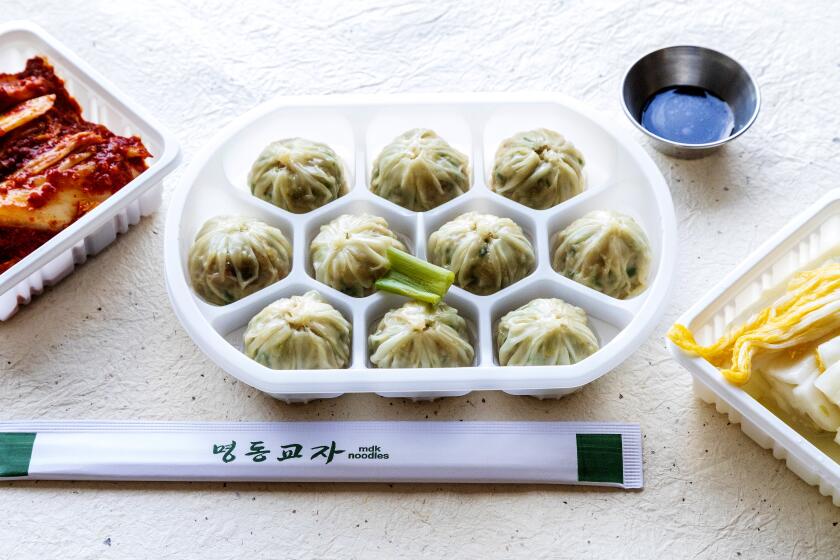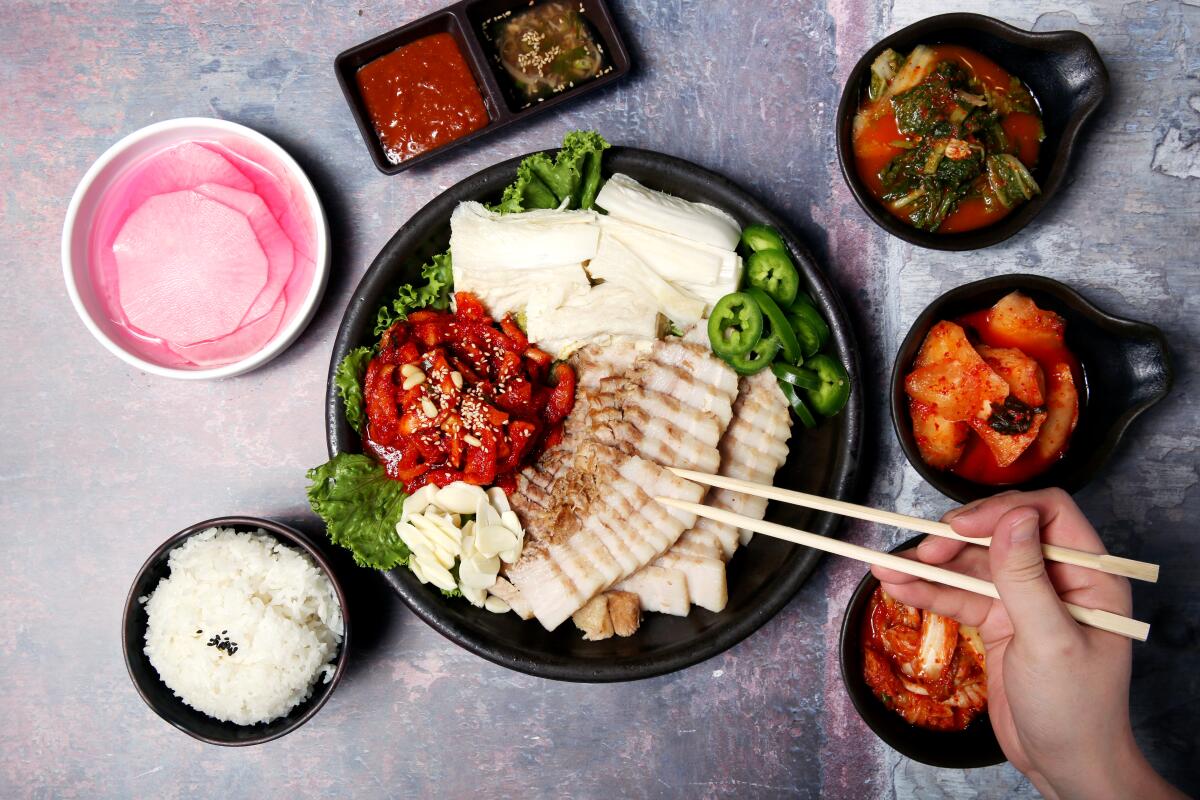
Bossam and a variety of banchan from Hangari Kalguksu in Koreatown.
(Dania Maxwell / Los Angeles Times)
How about a little Korean?
- Share via
You need more bossam in your life. You need more galbi jjim in your life. You need more kimchi in your life.
Let this guide to our critics’ favorite Korean restaurants from The Times’ 101 list make your life complete.
A list of where to eat in Koreatown.
Showing Places

(Dania Maxwell / Los Angeles Times)
Hangari Kalguksu
Koreatown Korean $$
| 2020
It’s difficult to overstate the virtues of kalguksu, hand-cut noodle soup, especially the seafood version at Koreatown’s long-running kalguksu specialist, Hangari Kalguksu. The delicately seasoned broth is light and herbaceous, thickened with clams, mussels, shrimp, crab and a fresh skein of thin yet firm house-made noodles that seem engineered to resist sogginess. It’s what you want to eat when you feel the first nascent chills of a cold move through your body, or any occasion that demands hot, nourishing sustenance. The oyster and rice soup called gul-gukbap, flavored with seaweed, is similarly delicate and nourishing. Milmyeon, the famed cold wheat noodles of Busan, are especially wonderful, paired with daeji kalbi, grilled pork spareribs. You eat the tender, spicy meat between slurps of noodles, in one or two glorious and meaty bites. There are many excellent bossam renditions in Los Angeles, but Hangari’s is especially good, a pillar of sliced pork belly flanked by sliced jalapeños and thickets of kimchi; it easily carries you through two or three full meals.
Read All Read Less
Route Details
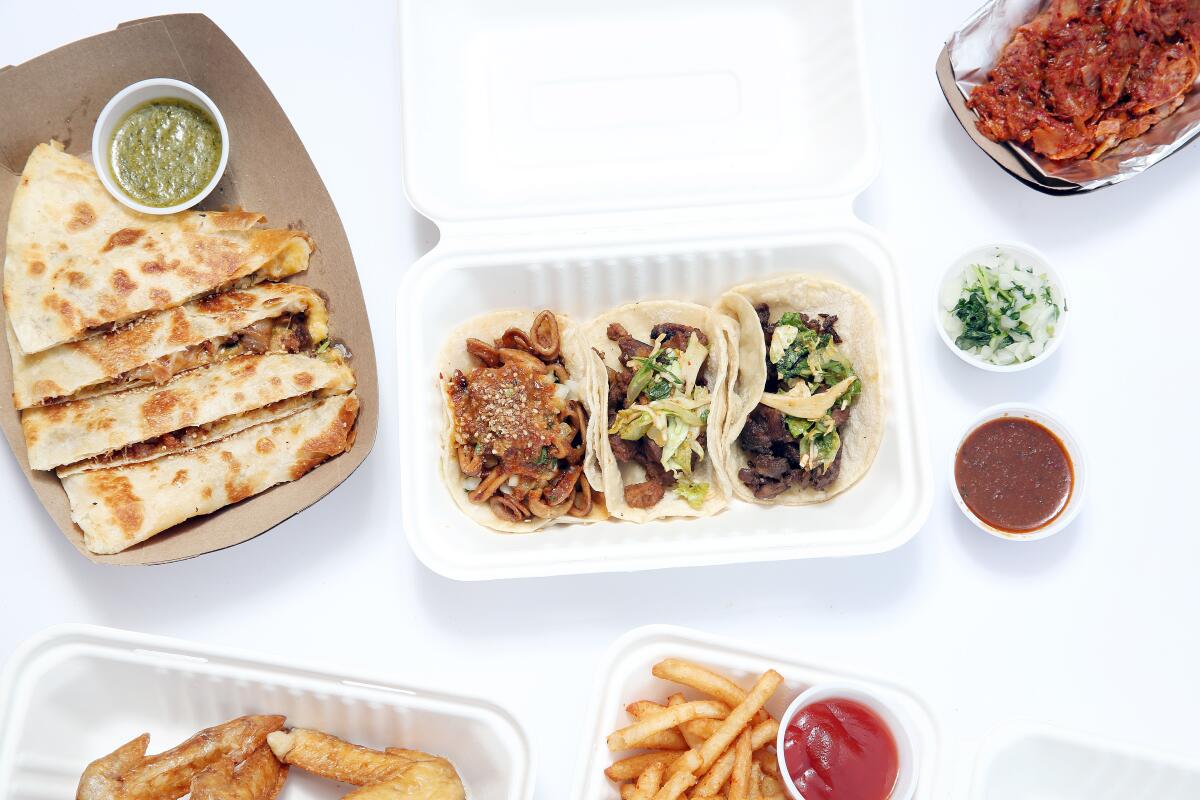
(Dania Maxwell / Los Angeles Times)
Kogi BBQ
Korean Mexican $$
| 2019 | #100
| 2020
Kogi BBQ was born during the golden age of L.A. food trucks, when the tattooed dude obsessively laboring inside the tiny, hot kitchen could turn out to be the chef guest-hosting your favorite Food Network game show. More than an emblem of L.A.’s cultural cross-pollination, Kogi’s laidback food-truck ethos has helped shape a whole generation of chefs. Closer in spirit to the glories of the venerable L.A. burger stand or taco truck than a high-toned restaurant kitchen, Kogi is perhaps more relevant than ever, reflecting the way many of us eat in 2020 — spicy kimchi folded into an exuberantly cheesy quesadilla, hot dogs spiked with Sriracha — while also presaging the rise of L.A.’s vital pop-up and ghost kitchen scene. The menu still surprises with its extravagance: A meaty burrito stuffed with spicy pork and lavished with glossy, brick-red mole was a standout from a recent specials menu, and a late-night “Pac Man” burger stuffed with chorizo and green chiles tastes gloriously of Los Angeles.
Read All Read Less
Details
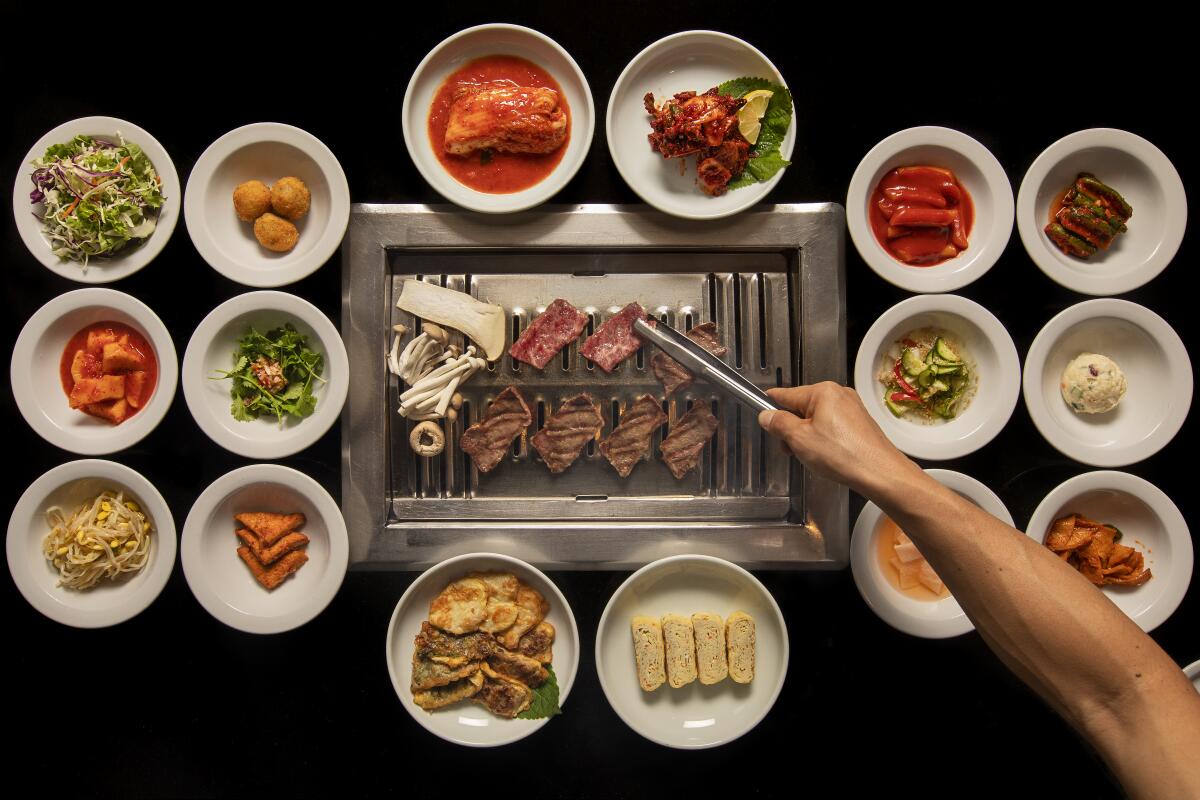
(Ricardo DeAratanha / Los Angeles Times)
Park's BBQ
Koreatown Korean $$$
| 2020
While it’s difficult to replicate the thrill of watching thin flaps of beef and pork belly crumple and caramelize on the grill right in front of you, Park’s takeout game is first-rate: richly marbled ggot sal, sheathed in carryout sheets of aluminum foil, is extremely tender. Beyond-prime beef short rib, marinated in Park’s garlicky, house-blend soy sauce, and scored by hand in places to ensure tenderness, is the kind of high-toned comfort food that makes any day a special occasion. Banchan, impeccably packaged in small to-go containers, is bright and fresh, and nonbarbecue dishes such as scarlet-colored kimchi jjigae, filled with jiggly cubes of tofu, are delicious and deftly prepared. If you prefer to replicate the Park’s BBQ experience at home, two doors down from the restaurant, the Parks 2 Go butcher shop sells a varied selection of superb USDA prime beef and sometimes even rare-breed pork belly.
Read All Read Less
Route Details
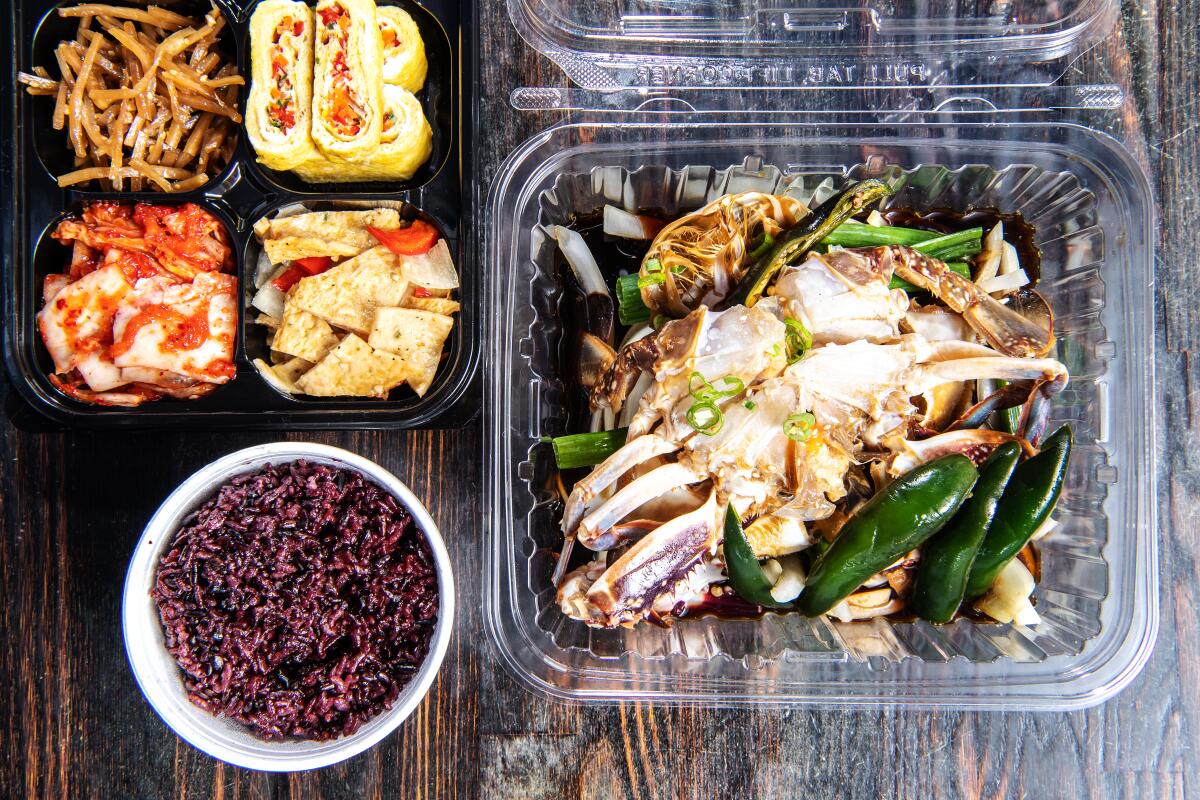
(Mariah Tauger / Los Angeles Times)
Soban
Koreatown Korean $$
| 2019 | #76
| 2020
When director Bong Joon Ho’s “Parasite” became the first non-English-language film in Oscar history to win Best Picture, cast and crew celebrated the groundbreaking victory with a private, predawn meal at Soban. Already beloved for its exceptional banchan, its indulgently braised short ribs and its famed ganjang gejang — raw blue crab marinated in a pungent, herb-infused soy sauce — the historic dinner further cemented the restaurant’s reputation as a Koreatown icon. Did the “Parasite” crew feast on seafood pancakes paved with soft, springy shrimp and crabmeat, or Soban’s famed braised cod stewed in red peppers? Hopefully there was thin-sliced pork bulgogi heaped with grilled onions, and platters of the chile-lavished octopus stir-fry called nakji-bokkeum. The dinner can be easily replicated at home; Soban’s menu translates to takeout form without losing any of the qualities that make the restaurant great: exacting yet soulful cooking that requires not even a tiny bit of fame or cinematic genius to be enjoyed.
Read All Read Less
Route Details
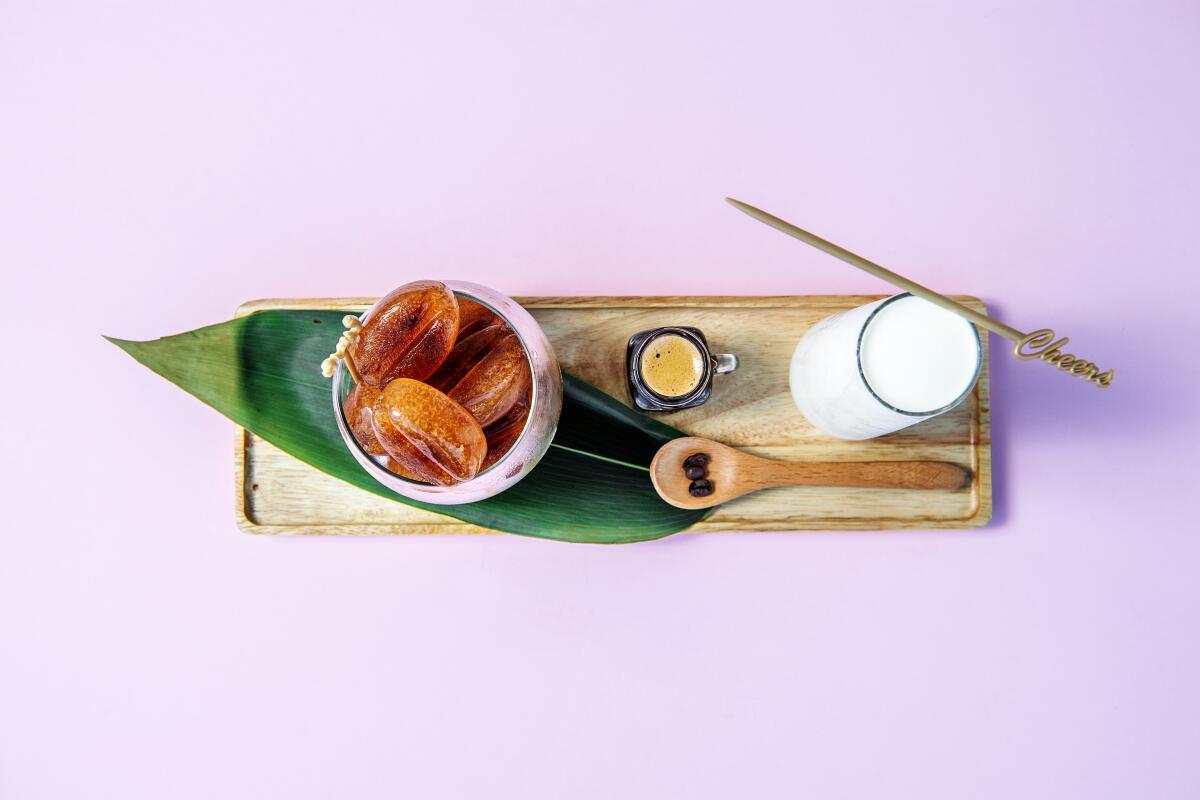
(Mariah Tauger / Los Angeles Times)
Spoon by H
Fairfax Korean $$
| 2019 | #62
| 2020
Yoonjin Hwang has a knack for creating dishes that stir buzz. In spring, when dining rooms went dark, she unveiled her version of a dosirak, the Korean lunch box served in cafes and carried by generations of elementary school students and families on picnics. A dosirak can be simple. Hwang’s was a Lite-Brite sketch of more than two dozen small dishes — galbijjim, chicken leg, fish cake japchae, several revolving salads, garlicky pickled peppers, pineapple salsa — assembled in a tray with six compartments. The hype got a bit much, and now Hwang offers them only occasionally: Watch her Instagram stories for the day’s menu. Dishes such as kimchi fried rice or ramen with oxtail and beef short rib may not be as kaleidoscopic but they gratify just as deeply. I admire that Hwang discontinued making her signature rice cake and pork dumpling soup during the catastrophe: Some things were meant to be savored in her cheering, communal dining room.
Read All Read Less
Route Details
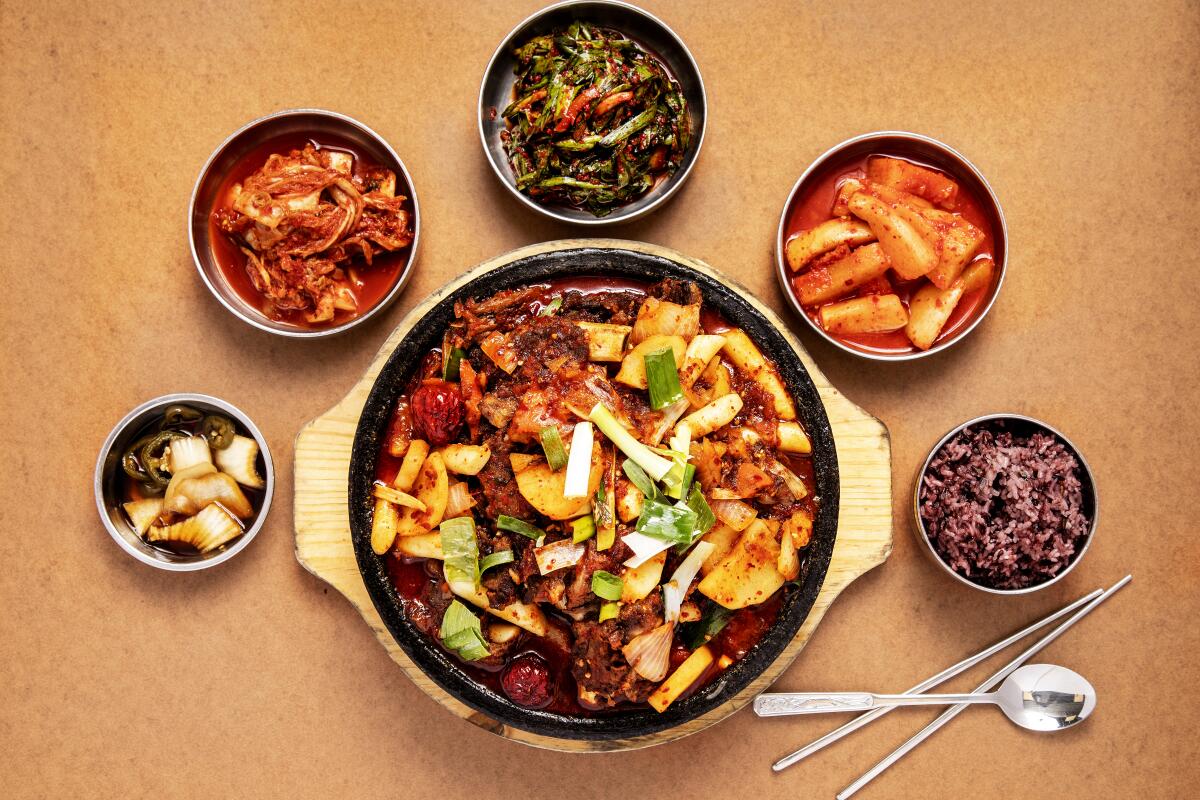
(Ricardo DeAratanha / Los Angeles Times)
Sun Nong Dan
Koreatown Korean $$$
| 2020
On a chilly day in Los Angeles, there’s nothing better than galbi jjim, braised beef short ribs stewed in a spiced gravy of vegetables, dried fruit and nuts until the meat begins to shrug off the bone. Sun Nong Dan, the 24-hour Koreatown seolleongtang specialist, offers what is perhaps the most over-the-top galbi jjim preparation in the city. The dish’s dramatic coda involves a server taking a blowtorch to the ribs to melt down fistfuls of shredded mozzarella cheese. In takeout form, the galbi jjim is more modest-looking, a disheveled mountain of beef and gravy squeezed into a carryout chafing dish. But it’s still a knockout of a dish, and it’s worth paying the extra $5 for cheese, which is already melted over the beef ribs — no blowtorch required.
Read All Read Less
Route Details
Eat your way across L.A.
Get our weekly Tasting Notes newsletter for reviews, news and more.
You may occasionally receive promotional content from the Los Angeles Times.
